#bobbit worm near
Explore tagged Tumblr posts
Text
Anglerfish mermaid Light WHEN
#death note#yagami light#i mean this in a symbolic way like it makes so much SENSE#the way light hunts is by lure. he looks all nice and pretty and you want to get close to him.#then all of a sudden you're close enough to see his teeth and then its too late#L is an octopus because he clings. you dont see him because its dark and then all of a sudden you run into a tentacle and its over.#he's eating you#also jellyfish misa#fluorescent jellyfish specifically#im in a sea life mood#bobbit worm near#dolphin mello#and vampire squid beyond that is all
57 notes
·
View notes
Text
Creeps and Crawlies
there's a theme here...
Deep sea life BBC. "Alien like colossal squid - Museum of Life - BBC Two." YouTube. April 16, 2010. Real Science. "The Insane Biology of: The Cuttlefish." YouTube. November 11, 2023. Real Science. "The Insane Biology of: The Octopus." YouTube. November 14, 2020. Real Science. "Why Animals Get Creepier the Deeper You Go." YouTube. June 10, 2023. Real Science. "Why Do Deep Sea Creatures Evolve Into Giants?" YouTube. July 16, 2022. Ze Frank. "True Facts About The Angler Fish." YouTube. December 27, 2012. Ze Frank. "True Facts About The CuttleFish." YouTube. October 30, 2013. Ze Frank. "True Facts About The Octopus." YouTube. April 1, 2014. Fungi National Geographic. "Glow-in-the-Dark Mushrooms: Nature’s Night Lights | National Geographic." YouTube. February 18, 2015. National Geographic. "What's in a Lichen? How Scientists Got It Wrong for 150 Years | Short Film Showcase." YouTube. January 25, 2018. National Geographic. "You Didn’t Know Mushrooms Could Do All This | National Geographic." YouTube. July 13, 2016. PBS. "How Trees Talk to Other Trees with the Help of Fungi | The Green Planet | PBS." YouTube. July 26, 2022. PBS Eons. "When Giant Fungi Ruled." YouTube. December 18, 2017. Ze Frank. "True Facts: Fungi That Control The Insects They Eat." YouTube. April 28, 2023. Ze Frank. "True Facts: Stinkhorns." YouTube. November 20, 2019. Slime molds BBC. "Mould Time-lapse - The Great British Year: Episode 4 Preview - BBC One." YouTube. October 18, 2013. BBC Earth Science. "Can Slime Mould Solve Mazes? | Earth Science." YouTube. December 5, 2018. Oregon Public Broadcasting. "Slime molds are gorgeous (you just never knew it!) | Oregon Field Guide." YouTube. January 3, 2022. Real Science. "The Insane Biology of: Slime Mold." YouTube. May 13, 2023. Ze Frank. "True Facts: The Self-Sacrificing Amoeba." YouTube. August 4, 2022. Ze Frank. "True Facts: The Smartest Slime." YouTube. January 31, 2023. Spiders National Geographic. "Deadly Cousin: The Redback Spider | National Geographic." YouTube. December 2, 2011. National Geographic. "How Spiders Use Electricity to Fly | Decoder." YouTube. April 25, 2019. Nature on PBS. "Social Spiders Spin Massive Nest." YouTube. April 14, 2015. Real Science. "Why Spider Silk is Stronger Than Steel." YouTube. January 15, 2022. Smithsonian Channel. "Incredible: This Underwater Spider Has an Actual Scuba Tank." YouTube. January 13, 2017. Smithsonian Channel. "This Terrifying Spider Hunts Fish Underwater." YouTube. May 26, 2017. Ze Frank. "True Facts: Mating Dance of The Peacock Spider (feat. Quinta Brunson)." YouTube. February 20, 2020. Ze Frank. "True Facts: Tarantulas." YouTube. November 19, 2022. Ze Frank. "True Facts: The Bolas Spider." YouTube. March 15, 2019. Ze Frank. "True Facts: The Ogre Faced Spider." YouTube. September 26, 2019. Worms ABC Science. "Blood-sucking leeches changed Cole’s life." YouTube. May 29, 2023. BBC. "The Amazing World Of Earthworms In The UK - Springwatch - BBC Two." YouTube. June 6, 2012. National Geographic. "Ice Worms | National Geographic." YouTube. September 17, 2007. National Geographic. "This Creepy Worm Pulls Its Prey Deep Under the Ocean Floor | National Geographic." YouTube. January 31, 2017. National Geographic. "Weird Worms Live Near Pacific Ocean’s Deepest High-Temp Vent | National Geographic." YouTube. June 11, 2015. Ze Frank. "True Facts: Bobbit Worm and Polychaete Pals." YouTube. August 17, 2018.
#worms#bugs#spiders#insects#science#reference#nature#fungi#octopus#squid#fish#ze frank#smithsonian#national geographic#natgeo#pbs#pbs nature#pbs eons#bbc#lichen#bioluminescence#trees#slime mold#amoeba
10 notes
·
View notes
Text






Eunice aphroditois is a benthic bristle worm of warm marine waters. It lives mainly in the Atlantic Ocean, but can also be found in the Indo-Pacific. It ranges in length from less than 10 cm (4 in) to 3 m (10 ft). Its exoskeleton displays a wide range of colors, from black to purple and more. This species is an ambush predator; it hunts by burrowing its whole body in soft sediment on the ocean floor and waiting until its antennae detect prey. It then strikes with its sharp mandibles. It may also be found among coral reefs.
Eunice aphroditois is also known as the bobbit worm or bobbitt worm. The name is believed to be taken from the John and Lorena Bobbitt case; however, another proposed reason is due to its jaw. It is sometimes called the sand striker. Another name associated with them is trap-jaw worm. Traces of their burrows have been noted in 2021 to have been found among fossils near Taiwan dating back twenty
These ambush predators have five antennae on their head that are used to sense prey. The body is covered by a hard exoskeleton. The mandibles can be retracted inside the body and are responsible for striking and stunning prey; they are capable of snapping some prey in half. Typically, E. aphroditois ranges from deep purple to black, with an iridescent skin. The largest known specimen on record reached 299 centimeters (9.81 ft) in length, making it the longest known member of the polychaete class. Despite these great lengths, the worms are slim, with the body only about 25.5 millimeters (1.00 in) wide.
This species may be found prowling among the prey-rich environment of coral reefs, where its coloration allows it to blend in and its slim body enables it to hunt in tight places. It inhabits a wide range of other habitats, particularly sandy and muddy sediments, as well as around rocks and sponges. It has been recorded at depths of up to 95 meters (312 ft).
Eunice aphroditois senses passing prey with its antennae, seizes the prey with their mandibles, and drags it into its burrow. This species is not only considered to be a carnivore, feeding on a plethora of species of fish, but it can also be considered an herbivore/omnivore, feeding on algae, as well as a decomposer, feeding on dead and decaying matter.
To reduce predation risk, some fish engage in mobbing behavior, during which a group of fish will direct jets of water into the worm's burrow to disorient it.
Ancestral species may have exhibited the same hunting behavior 20 million years ago, according to fossil-records.
#deathmothblog#beauty of nature#nature#wildlife#animals#sea creatures#sea life#artists on tumblr#bobbit worm
7 notes
·
View notes
Note
Silly Game Time: Change one letter of a media title, and tell us what that different media would be about.
For example, "Taken" (a movie where Liam Neeson seeks bloody vengeance against the men who kidnapped his adult daughter) becomes "Waken" (a movie where Liam Neeson seeks bloody vengeance against the men who woke up his baby daughter).
The Hobbit to The Bobbit. Bobbitt worms are just little guys! I'd put a photo of them here but uh. They're considered as an inspiration to the Alien movie's aliens for a reason but leaning more towards centipedes and millipedes. Honestly they're kind of adorable in the sense of "you're cute in the glass tank but come near me and I will have no hesitation on enacting Darwinism on you"
Oh gods the marine biology obsession is infectious, ruN FOR YOUR SANITY!!!
3 notes
·
View notes
Note
the bobbit worm is a predatory worm that lives at the seafloor
When a fish gets near, it lunges out incredibly quickly and grabs it, pulling it back to its burrow
its found it has some kind of venom to immobilize it's prey
they have 5 antennae used to detect prey, and can move in short bursts up to 20 feet per second
They can get up to ten feet long
They can move so fast they even cut their prey in half occasionally
Also as I was looking up bobbit worm facts appearantly they are actually omnivores.
I hope this is enough information about the wonderful bobbit worm
<APIS> Wow...
<APIS> THAT'S SO EPIC!!!!
<APIS> I bet they're, like, SUPER cute with all those little antennae!! Or big antennae... jeez, those guys can get super big.
<APIS> Omnivores.. I wonder if they have a preference? I know some centipedes like sweet treats! Voidddd they're so CUTE...
<APIS> This is a lot of great info, thanks so much!!!!
4 notes
·
View notes
Text
I don't know what any of this means but I love how the drawings go from a group of creatures dancing near a pillar to creatures fighting eachother to a giant space snake, anomalocaris, ammonite and nudibranch overlooking the earth to a shrimp with a top hat singing at a bar to a crab holding a concert then to leaves with eyes surrounded by bones and then all of this ends with a giant bobbit worm
I don't like to reblog things with nudity but there's a shrimp with a top hat and I want you guys to see it. also the art is really good
hey remember that 7-month, 36-artist game of art telephone i hosted last year? well hold onto your assholes and prepare for:


SEE IT ALL HERE!
there's also no reasonable way of fitting all of the submissions into a single tumblr post without crushing all the detail out of everything to satisfy the 30-image limit per post so i'm gonna have to make a whole chain to feature all the kickass art:
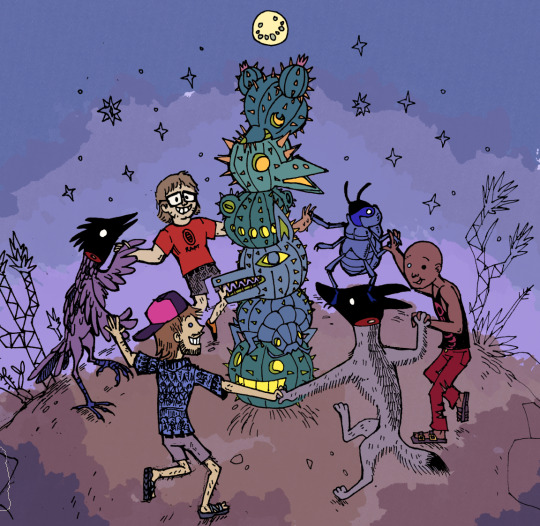
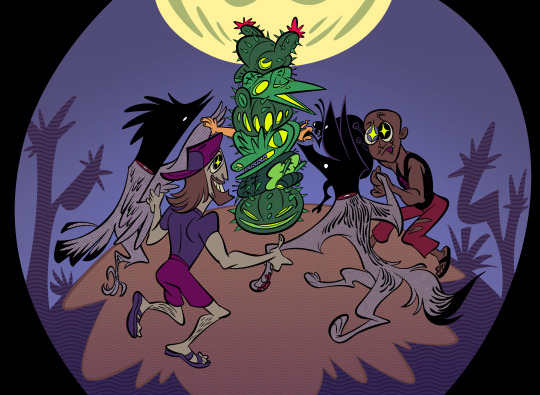

1-3: @bedupolker @psshaw @slabmangrave
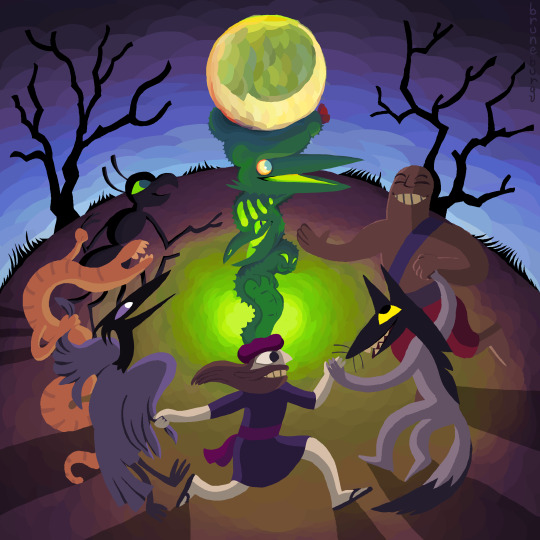
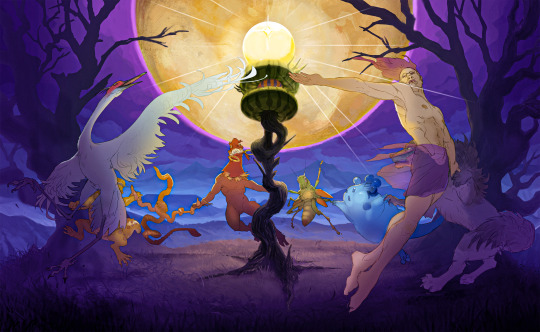

4-6: @bruneburg @whip-o-will @thedancingemu
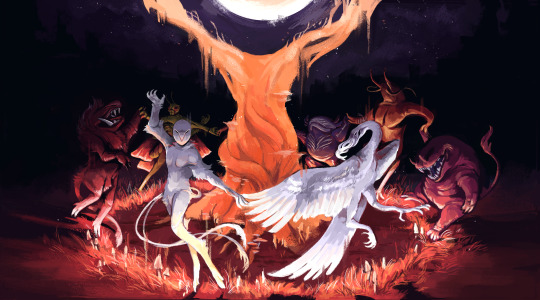
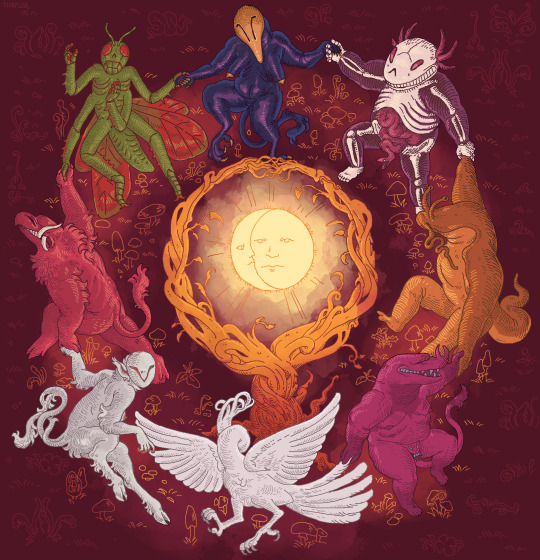
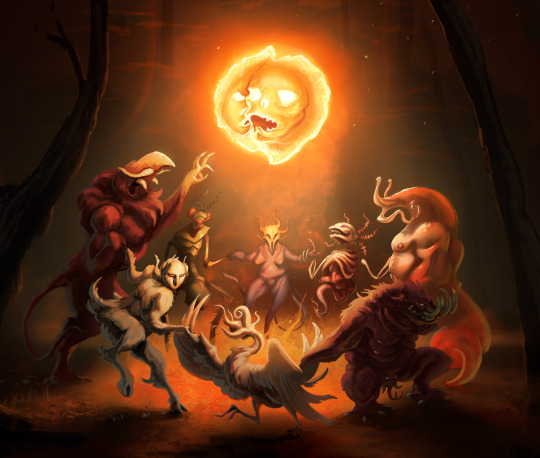
7-9: @odetoscavengers @tickflea @deadlydaemondraws



10-12: @charseraph @biomechanicalmush @ungeziefer

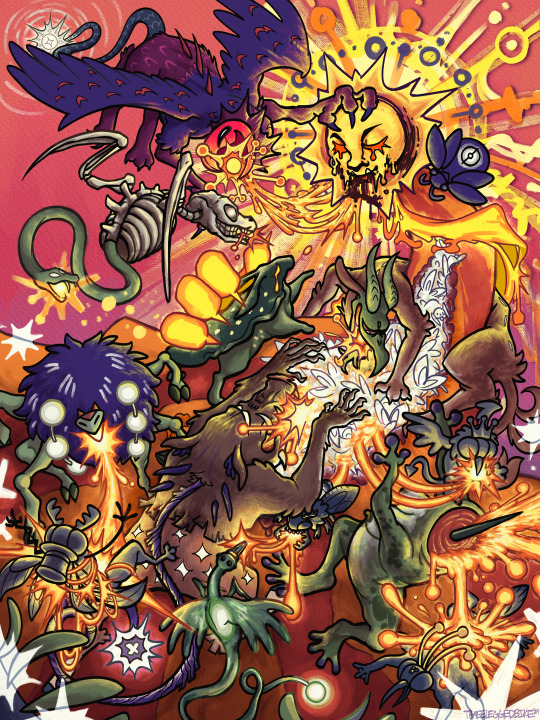
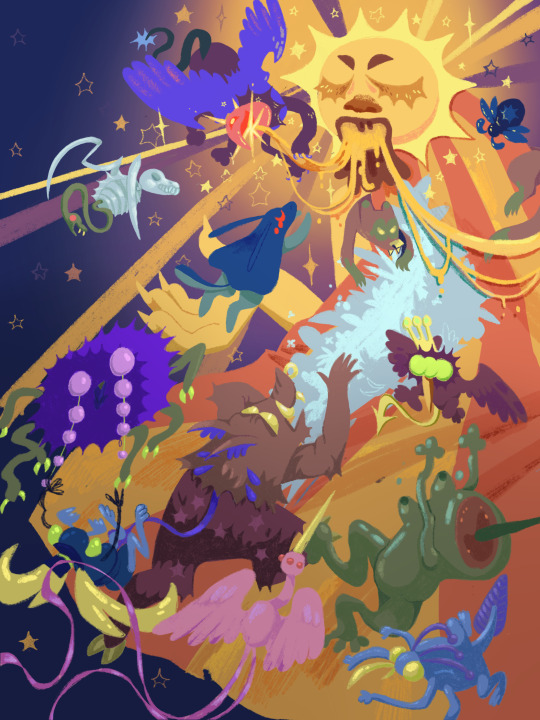
13-15: @barabones @threeleggedart @phanta-friends
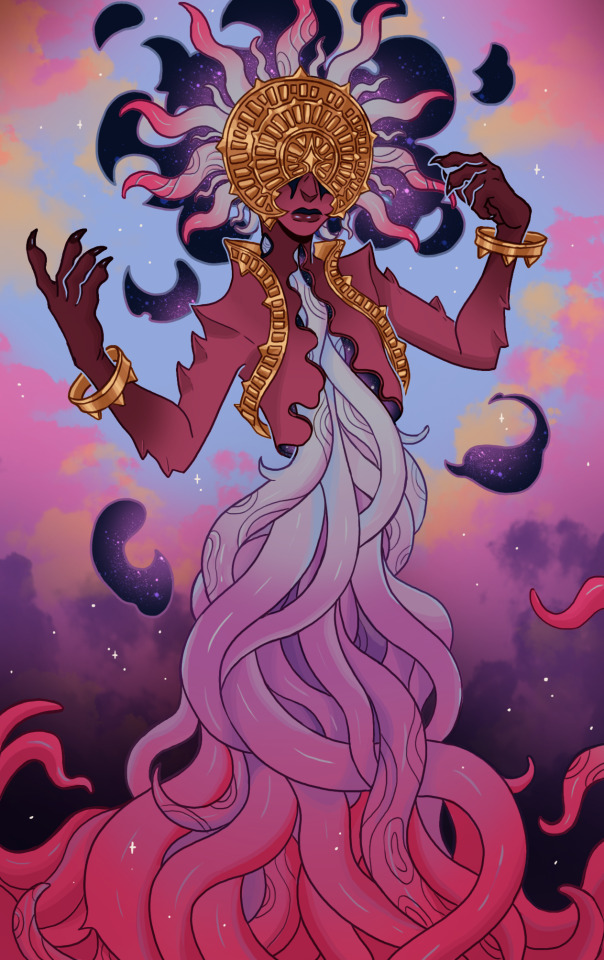
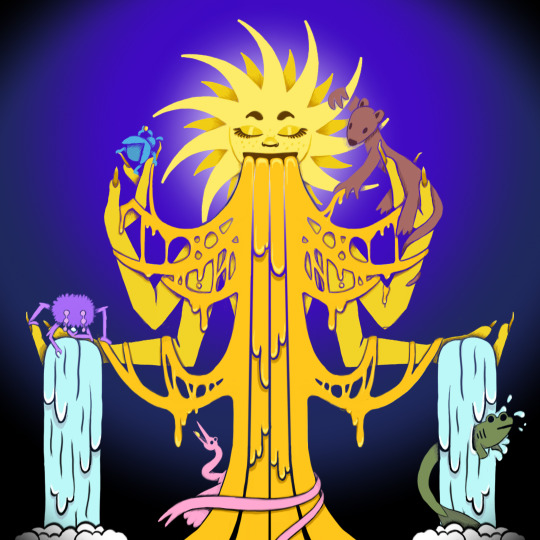

16-18: @snejkha @librivore42 @edenartfactory


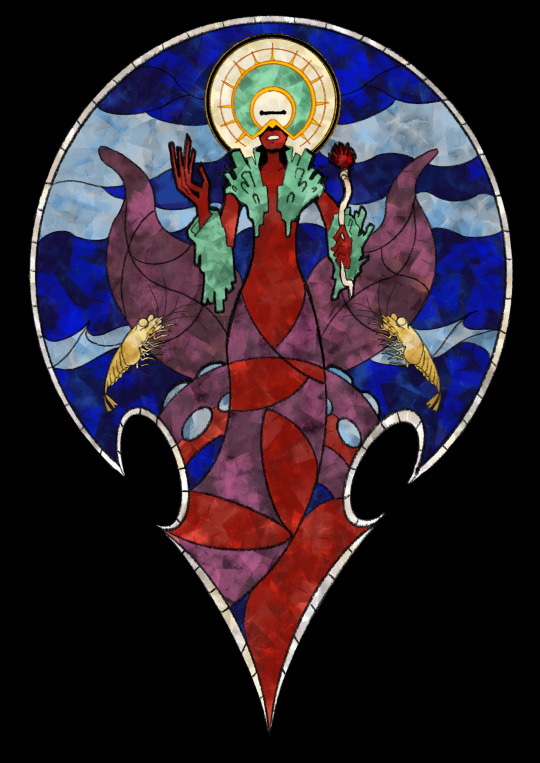
19-21: @lymphwyrm @palossssssand @gachimushi


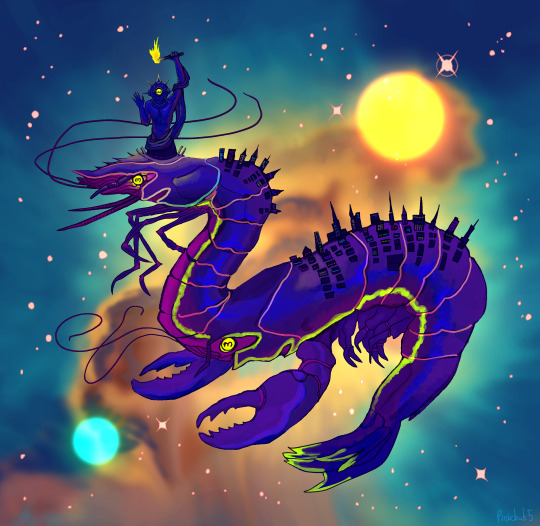
22-24: umberfossil justagoldfish @pinkbat5

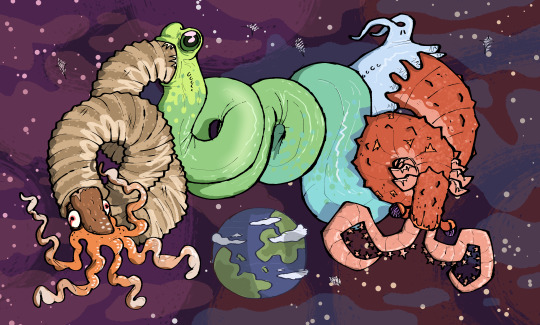

25-27: @solidagold @nutspider elixer
DON'T REBLOG YET WE'RE NOT EVEN HALFWAY THROUGH!!!
4K notes
·
View notes
Text
the woes of having a marine biology special interest
im like the only person in my friend group who knows a lot about the ocean and it leads to some absurdly dumb situations where i end up explaining to every new friend i make about bobbit worms
i think they're hilariously murderous creatures and its really funny showing new people the death worm but like, ive told like seven people about them >~<
i think they're cool in their own uniquely freaky way, little dudes on the bottom of the ocean who murder every thing they can, tw below because they are pretty freaky dudes

the brainless evil murderous scwumbo,,,,,,,,,,,, i find them fascinating that they dont possess a brain and thus have no cognitive thought of being, their only means of hunting is antennae that detect when prey is near by.
1 note
·
View note
Text
I had a horrible thought, and now I must share it all with you.
*sighs*
Jane Prentiss but she’s bobbit worms.
#the magnus archives#tma#jane prentiss#worms /#as in like bobbit worms in her instead of the flesh hive worms#as if i wasn't already terrified of her already#fun fact about me is that i'm terrified of a lot of types of worm#and both helminths and bobbit worms are quite high on this don't fucking come near me scale#ask to tag#art talks about stuff
35 notes
·
View notes
Text
OFMD characters if they were worms
(and whether or not I would still love them)
Izzy: Pseudobiceros hancockanus
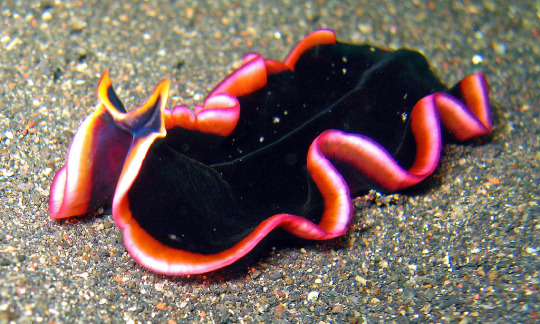
Also known as "Hancock's Flatworm," it has a distinct black coloring and is part of a genus known for engaging in "penis fencing" for reproduction, which I like to imagine is something Izzy does too. Obviously I would still love him; I don't think there's anything that could make me stop loving him.
Stede: Sabellastarte spectabilis
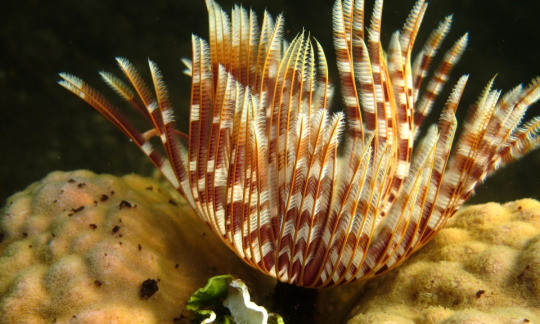
Also known as the "feather duster worm." It's popular in squariums because of its flamboyant plume of tentacles, which are almost as ridiculous as Stede's hair. If anything I think I'd love him more as a worm.
Ed: Eunice aphroditois
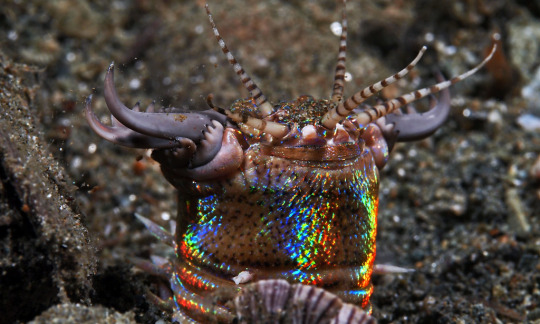
Also known as the "sand striker" or "bobbit worm." This thing is a horrifying monster that feeds on fish unfortunate enough to come near it with its sharp mandibles. The rainbow iridescence is pretty though. Sorry Ed but I've read too many horror stories about these; I would not love you if you were a worm.
Calico Jack: Trichuris trichiura
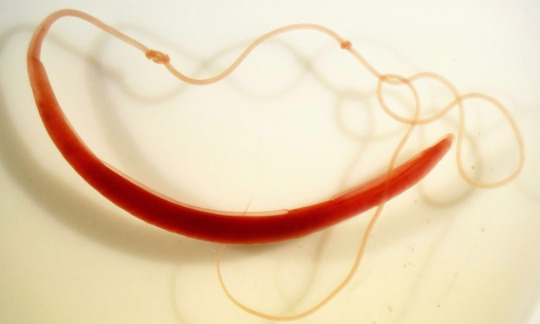
Also known as the "whipworm," which is the only reason I chose it. Unlike Calico Jack, I wouldn't want one of these in my large intestine because they're the cause of trichuriasis, a parasitic infection. I'm not that into parasites so I'm unfortunately going to have to pass on loving Jack as a worm.
Roach: Hirudo medicinalis
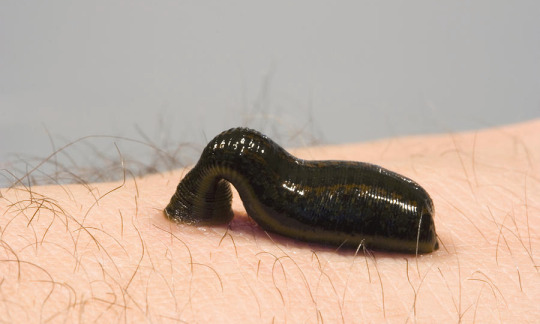
One of a few species of "medicinal leeches." Leeches are still used for medical purposes to this day because of the beneficial secretions in their saliva, and they're also cool as fuck. They're like vampires except they're worms, so obviously I'd still love Roach as a worm.
Frenchie: Lagis koreni
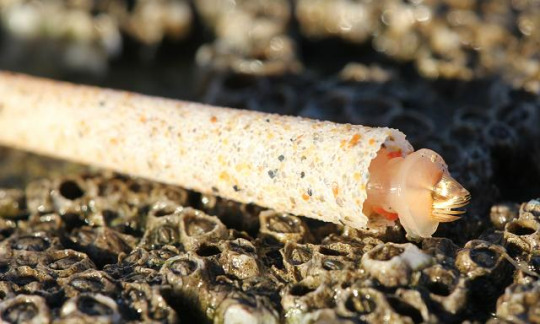
Frenchie is a "trumpet worm" because that was the only worm I could find with a name related to music. Also the tubes they build for themselves to live in are super cool and I wanted to include them somewhere. I would for sure love him if we was a worm.
Wee John: Megascolides australis
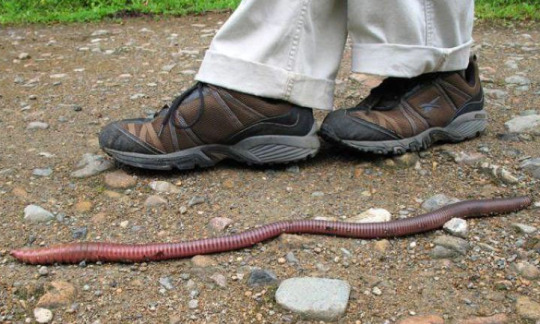
Also known as the "giant Gippsland earthworm." Because he's big, get it? 10/10, would still love him as a worm.
Lucius: Spirobranchus giganteus
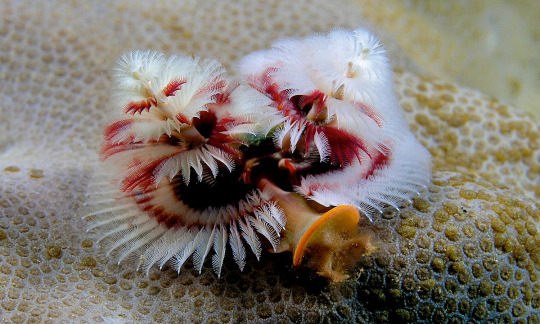
Commonly known as the "christmas tree worm." The two spiral things on either side of its body function both as gills and to capture food, and they're also gay as fuck. Love that for him, and I'd absolutely love him as a worm.
Jim: Bipalium kewense

Jim is a "hammerhead flatworm," mostly because it kind of looks like it's wearing a hat but also because it produces a deadly paralyzing neurotoxin. Obviously I love that, and I'd love them if they were a worm.
Oluwande: Maritigrella crozierae
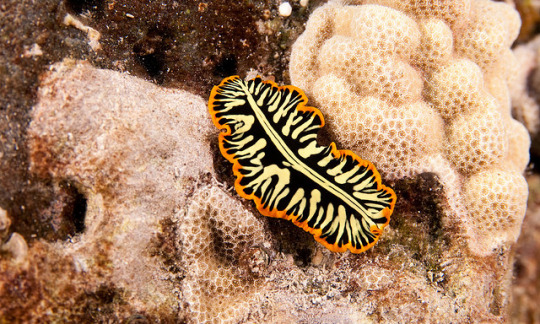
Commonly known as the "tiger flatworm." I chose this for Oluwande because they apparently often live together in pairs and Jim/Oluwande is the best couple in the show. You already know I'd still love him if he was a worm.
Buttons: Plagiostomum vittatum
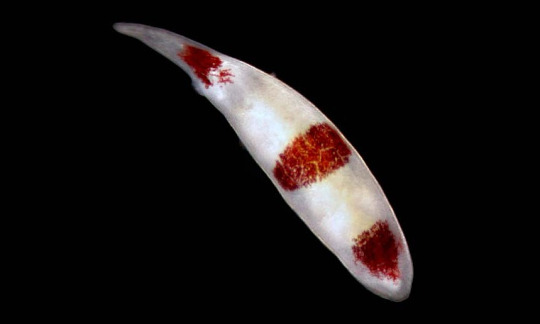
Not much is known about this mysterious species of marine flatworm aside from the fact that it's native to the Atlantic ocean (by which I mean there isn't a Wikipedia article for it and I can't be bothered to do more research). I do like a mystery so yeah, I'd love him if he were a worm.
Fang: Hermodice carunculata

The "bearded fireworm," like Fang, looks soft but is also deadly. It's namesake white bristles are capable of penetrating skin and injecting a powerful neurotoxin. I would love him if he was a worm but I'd keep my distance.
Ivan: Arthurdendyus triangulatus

Known as the "New Zealand flatworm," it fades into the background a bit but it's still cool. Apparently they roll up when they rest which would be really cool if I could find a picture of it. Anyways yeah I'd love him as a worm.
The Swede: Caenorhabditis elegans

C. elegans is a species of nematode notable for being the first multicellular organism to have its entire genome sequenced, because it's so simple. I'd definitely love him as a worm.
Black Pete: Lumbricus terrestris
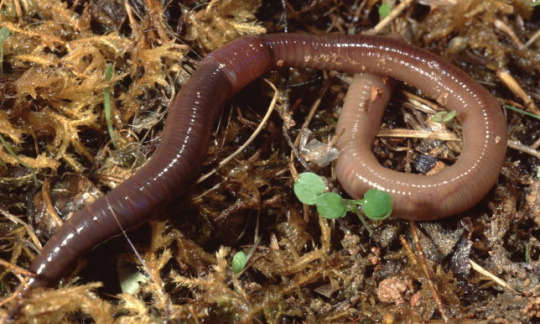
The common earthworm. It's a bit plain, but it plays a vitally important role in its ecosystem. Of course I'd love him as a worm.
Mary: Riftia pachyptila

Also known as the "giant tubeworm," it's capable of surviving in the extremely hot, toxic environments of deep-sea vents, which is almost as impressive as Mary being able to survive living in a house with Stede. Obviously I'd still love her as a worm, she's an icon.
#i spent so long researching worms for this post you'd better not let it flop#i feel like i shouldn't have to say this but don't read this if you don't want to see a bunch of pictures of worms#our flag means death#ofmd#izzy hands#stede bonnet#edward teach#calico jack#roach ofmd#frenchie ofmd#wee john feeney#lucius spriggs#jim jimenez#oluwande boodhari#nathaniel buttons#fang ofmd#ivan ofmd#the swede#black pete#mary bonnet#shitpost#long post
165 notes
·
View notes
Text
some quick'n'dirty thoughts on the new Codex entries:
[wild speculation] it feels like the Grand Necropolis is a game location we will visit (it also comes up quite a bit in the wider blogpost). and/or we'll have a Mortalitasi companion
I'd guess that the writer of this codex, and their friend that teases them, are the two characters that feature in the short story from Dragon Age Day last year, The Flame Eternal. Emmrich referring to Johanna? (Or just emmrich and someone else.. wouldn't really make sense for a nevarran to tease their nevarran friend about their own practises, on reflection). both that short and this new codex are by Sylvia, and the shade of cyan used to obscure the diary owner's name is similar to the cyan in the short story art. saying that, it's the same cyan as Skeleton Boi has, and seems to sometimes indicate necromancy & related magic generally speaking
I could've missed em, but I had a lil look and couldn't find the referenced writings of Genetivi's here or in the WoTs, so they must be among his many in-world writings that we the players haven't seen (it'd be so good to sit in an an in-world library and read and read and read..!!! literally the dream.). but if I missed them pls lmk :D
Vinsomer. the Last Court/Serault enthusiast in me wonders if the lecturer giving the talk on Vinsomer is Frederic of Serault, Professor of Draconology from the University of Orlais. Vinsomer can swim! makes sense, we meet one in DA:I on the Storm Coast and the lore says they prefer rocky coasts.
Thedas has orcas confirmed~ when an animal is dark dorsally and light ventrally, it's called countershading. it's a method of camouflage. in orcas this helps hide them from their prey. there's a squidlike creature on this version of the map, and the "big worms that burrow near the shore" remind me of thresher maws from ME. Thedas has giant bobbit worm type things on the beaches?? 😭 electric eels stun their prey by generating electricity, and it makes sense that a big creature that hunts in the sea would have a beak-like mouth like squid do. the biologist in me is pleased by these references and the thought that clearly went into this codex :D
what's attacking Vinsomer/her lair/her young and why is it a mystery? it's probably because I was thinking about the red lyrium skeleton guys again today just before the community update post came out (literally ten-fifteen mins or so before the blogpost aaaa), but the new Vinsomer codex reminds me of this excerpt [bottom one] for some reason: "From eyewitness reports, the adult dragons never ventured close to where the red lyrium grows, even though they could easily have done so. I can only conclude that the creatures instinctively understand that red lyrium poses a threat."
skskshfuehufh the double entendres in the Randy Dowager codex. Genetivi you rogue
and more generally speaking, this part of the blogpost:
The Hero of Ferelden. The Champion of Kirkwall. The Herald of Andraste. Each of them marked their legacy in the annals of history, but time marches forward and the age of these heroes cannot last forever. As a friend of ours once said, “it’s time for a new hero."
has me wondering for the 89898th time what the DA4 PC's title will be if any. the what of what??? :D I'm dyin. I wonder if time marching forward ties to the implied timeskip to 9:52, and it's exciting to know that there will be other upcoming community updates like this, with the next one being focused on Design. hope the next one contains some new Codex entries too! 👁
#dragon age: dreadwolf#dragon age 4#the dread wolf rises#da4#dragon age#bioware#video games#long post#longpost#mj meta#- bls hh dont take the orca comment so srs#Ik & the link included says that its found in many spp.#my bg is in bio and im just freakin about the ref to/inclusion of countershading HH
202 notes
·
View notes
Note
Top five Thagomizers wurms.
5. Worm on a string, look at that fuzzy harbinger of destruction.

4. Purple Worm, Not as dangerous as the above one, but still dangerous, acid is a plus.

3. Olgoi-khorkhoi, The Mongolian Death Worm. It can eat you, touching it is deadly, and apparently it can stop vehicles from starting.

2. Bobbit Worm, This ambush predator scares me to no end, I’m in a mostly landlocked location nowhere near one of these not in captivity and I’d still probably scream if I saw one.

1. Graboids, Tremors is hands down my favorite monster movie and I don’t care that this one probably couldn’t fight off anything but the Bobbit worm, they just hold a special place in my heart.

24 notes
·
View notes
Photo

Beneath the ocean floor lurks a giant marine worm that can grow 10 to 20 feet (3 to 6 meters) long: the bobbit worm (Eunice aphroditois). It’s a ravenous predator that burrows underground with its head facing upwards, waiting for prey. It doesn’t have eyes or a brain, but it does have five antennae that it sticks out above the sand to sense for and lure in unsuspecting fish. When prey get near, the bobbit worm strikes at a lightning speed with powerful jaws, snatches its meal, and pulls it down below. Photo: Jenny Huang https://www.instagram.com/p/B5okakLAoAk/?igshid=1es6hbx68wc5s
433 notes
·
View notes
Text
argentarachnids replied to your post “Besides riding my bike in circles around Bridge Field to hatch eggs,...”
Do you know where they are?
In Motostoke, there’s a staircase in the foreground of the upper level near the pokemon center that takes you all the way down to like a basement level. I found it by accident after trying to retrace TyranitarTube’s steps.
argentarachnids replied to your post “I thought up a revamp for my bobbit worm fakemon. Middle stage Ragrand...”
Cramorant for biting moves
Terror Jaw activates when Bobbite uses a biting move, switching it from Jaws In Mode to Jaws Out Mode. While in Jaws Out Mode, every biting move it uses raises its attack by one stage. If it uses a move aside from biting ones, loses its ability, faints, or is switched out, it reverts to Jaws In Mode.
1 note
·
View note
Photo

Daily D&D Monster: Purple Worm
From the same dimension as the thri-kreen, the (misnamed) worms are somewhat of a missing lineage in our own dimension. Speculated to be somewhere between uniramians and chelicerates, these creatures use a more snake-like method of moving around and capturing prey. Like all animals from the thri-kreen's home dimension, they evolved unique ways of living in a more oxygen-deprived world after the end of an extended Carboniferous era. Nearly every large animal on their planet is an arthropod, with only a few amphibians and reptiles on land. The worms have an enormous family, with dozens of species having been relocated to our own world. Unarguably the largest are the purple worms, which use a bobbit-esque hunting strategy. Although the length of a purple worm is much smaller than that of a bobbit worm, in terms of girth they're up there with anacondas and boas. To help burst from their hidey-holes, they have specialized muscles in their lower halves strong enough to lift themselves out and shake their body with enough force to incapacitate any prey. Small arms near the head and a strong pair of jaws capture whatever's above and drag it beneath. Though, like all large predators, they start out quite small, and are often prey to other predators. Purple worms begin digging their homes from birth, making sure to stay far enough away from their siblings and parents.
1 note
·
View note
Link
Deep sea discovery: Fossils reveal ‘ambush‐predatory’ worms ruled ancient seafloor Newly earthed fossils from Taiwan have revealed a serpentine prehistoric predator ambushed its unsuspecting prey by shooting from its underground seafloor lair. These monster worms may have been ancestors of trap-jawed modern Bobbit worms (Eunice aphroditois). These also secrete themselves in burrows under the ocean floor and can grow to be 10ft (3m) long. New fossil suggest their ancestors, living approximately 20 million years ago were L-shaped and grow up to about 7ft (2m) long and(2 to 3 cm) in diameter, researchers have reported. Professor Ludvig Löwemark, a National Taiwan University sedimentologist involved in the study, said: “After 20m years, it’s not possible to say whether this was made by an ancestor of the Bobbit worm or another predatory worm that worked in more or less the same way. “There’s huge variation in Bobbit worm behaviour, but this seems very similar to the shallow water worms that reach out, grab fish and pull them down.” JUST IN: T-Rex fossil find opens ’window into the early lives of tyrannosaurs’ Professor Löwemark said: “This results in the stack of cone-in-cone structures that form the ‘feathers’ around the uppermost part of the tube.” The study’s authors wrote: ”We hypothesise about 20 million years ago, at the southeastern border of the Eurasian continent, ancient Bobbit worms colonised the seafloor waiting in ambush for a passing meal.” They added how the worms “exploded” from their burrows when prey approached, “grabbing and dragging the prey down into the sediment.” The scientists continued: “Beneath the seafloor, the desperate prey floundered to escape, leading to further disturbance of the sediment around the burrow opening.” As the ancient worms retreated deeper into their tunnel with the thrashing prey, the struggle agitated the sediment, creating their ”distinct feather-like collapse structures”. The researchers also detected iron-rich pockets in disturbed areas near the tops of the tunnels. These probably appeared after worms reinforced the damaged walls with layers of sticky mucus. And although no fossilised element of the worms were found, the scientists did manage to categorise a new genus and species, Pennichnus formosae, to describe the ancient animals, based on their burrows’ distinctive forms. The scientists concluded: “The likely behaviour that created the tunnels “records a life and death struggle between predator and prey, and indirectly preserves evidence of [a] more diverse and robust paleo-ecosystem than can be interpreted from the fossil and trace fossil record alone.” if(typeof utag_data.ads.fb_pixel!=="undefined"&&utag_data.ads.fb_pixel==!0)!function(f,b,e,v,n,t,s)if(f.fbq)return;n=f.fbq=function()n.callMethod?n.callMethod.apply(n,arguments):n.queue.push(arguments);if(!f._fbq)f._fbq=n;n.push=n;n.loaded=!0;n.version='2.0';n.queue=[];t=b.createElement(e);t.async=!0;t.src=v;s=b.getElementsByTagName(e)[0];s.parentNode.insertBefore(t,s)(window,document,'script','https://connect.facebook.net/en_US/fbevents.js');fbq('init','568781449942811');fbq('track','PageView') Source link #ambushpredatory #Ancient #deep #Discovery #fossils #Reveal #Ruled #Sea #seafloor #worms
0 notes
Text
Scientists Find 20-Million-Year-Old Giant Predatory Nightmare Worm
It reads like a scene that might unfold on fictional planets like Arrakis or Tatooine: giant worms that lurk in underground lairs “until they explode upwards grabbing unsuspecting prey with a snap of their powerful jaws” then pull the “still living prey” into the sediment to be consumed.
But those quotes aren’t from any science fiction novel; they are from a study published on Thursday in Scientific Reports that describes the feeding behavior of the Bobbit worm, or “sand striker,” a living species of marine worm that hides in the seabed in order to ambush its targets.
In the new study, scientists led by Ludvig Löwemark, a marine geoscientist at National Taiwan University in Taipei, announced the discovery of a possible extinct ancestor of the Bobbit worm, measuring some two meters (or six feet) in length, that terrorized Eurasian seafloors some 20 million years ago.
Marine worms have been roaming the oceans for hundreds of millions of years, but they are primarily made of soft tissue, which does not fossilize as easily as bone. As a result, it is extremely rare to find traces of these animals in the fossil record.
But while their bodies are ephemeral, Löwemark and his colleagues identified their L-shaped burrows, which measured about two meters in length and two to three centimeters (about one inch) in diameter.
“The worm probably was similar in size,” Löwemark said in an email. “The thin, smooth lining around the burrow suggests that the worm filled out the tube most of the time.”

A modern Bobbit worm. Image: Smithsonian Institute
The fossilized burrows represent a “new ichnogenus,” meaning a group of animals identified by the traces they left behind rather than their bodies, which the team named Pennichnus. The discovery is based on an exhaustive survey of 319 trace specimens preserved in sandstone sediments across Yehliu Geopark and Badouzi promontory in Taiwan.
“We studied all the specimens that we could find in the field by taking measurements on length, diameter, burrow structure etc. and a selected number of specimens were cut out using a rock cutter and analyzed in the lab,” explained Löwemark. “In addition, a few samples were polished in the field using a grinder to allow us to study serial vertical sections or the specimen by removing millimeter by millimeter of rock.”
“In most cases, we could only see a part of the trace fossil because it is so large,” he added, “but in a few lucky instances we found almost complete specimens.”

Dr. Masakazu Nara (Kochi University, Japan) and Ms. Sassa Tzu-Tung Chen (Gothenburg University, Sweden) at Badouzi, NE Coast, Taiwan, sampling the new trace fossil using a rock cutter. Image: Ludvig Löwemark.
Taken together, the specimens paint a picture of a spectacular ambush predator that probably used similar hunting tactics to modern day Bobbit worms, which can also grow to two or three meters long. Collapsible feather-like structures found in the trace fossils suggest that the burrows were partially damaged by each ambush, only to be repaired by the worms and strengthened by mucus they secreted along the walls, which appears to have enriched the sediments near the tops of the burrows with high iron concentrations.
“When prey came close to a worm, it exploded out from its burrow, grabbing and dragging the prey down into the sediment,” the authors wrote in the study. “Beneath the seafloor, the desperate prey foundered to escape, leading to further disturbance of the sediment around the burrow opening.”
“The interpreted activities of the Pennichnus trace maker records a life and death struggle between predator and prey, and indirectly preserves evidence of a more diverse and robust paleo-ecosystem than can be interpreted from the fossil and trace fossil record alone,” the team added.
Löwemark and his colleagues hope to learn more about these marine worms, both extinct and living, and their nightmarish predatory success, which has persisted over huge timescales.
“An interesting question is why this trace fossil is confined to a few distinct layers although similar environments existed in this region for several million years,” Löwemark concluded. “I would also be curious to study modern Bobbit worm burrows of course!”
Scientists Find 20-Million-Year-Old Giant Predatory Nightmare Worm syndicated from https://triviaqaweb.wordpress.com/feed/
0 notes